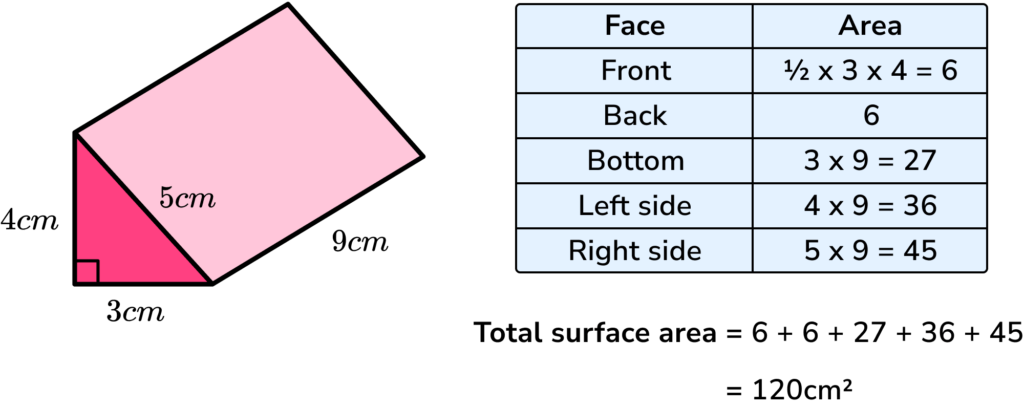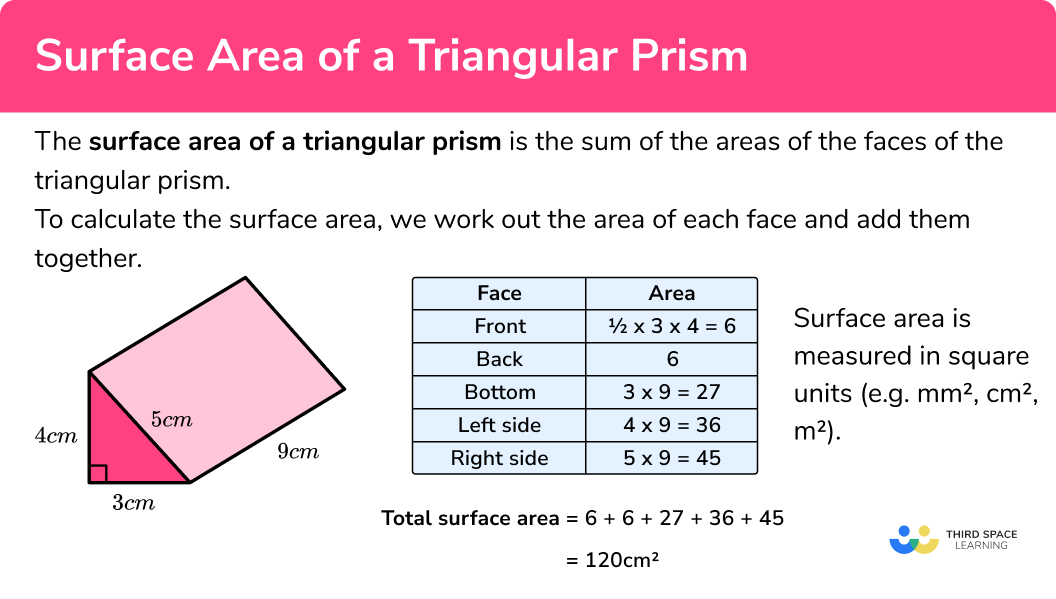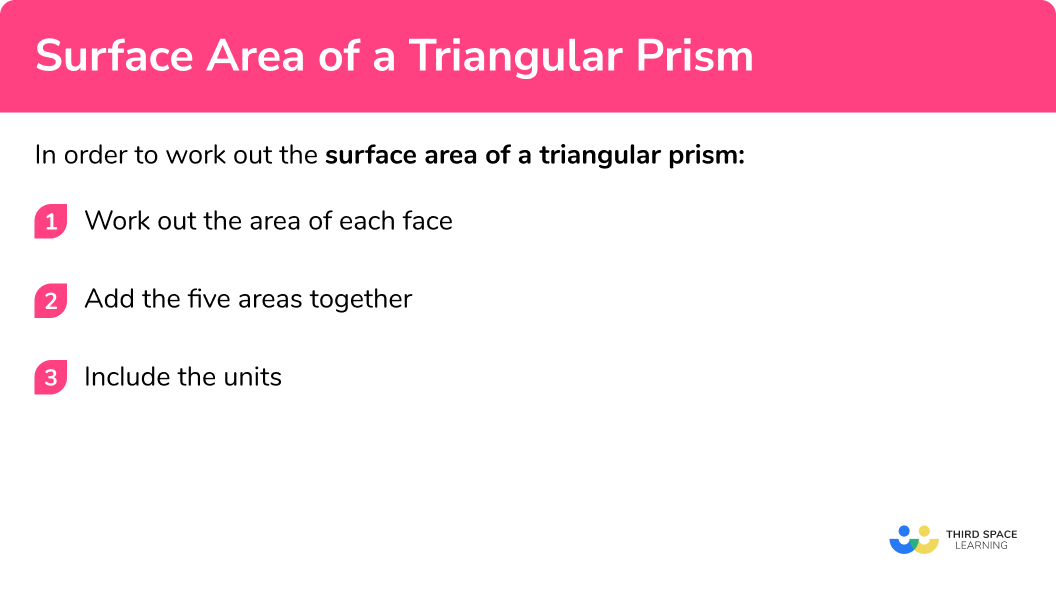
Here we will learn about the surface area of a triangular prism and how to calculate it.
There are also volume and surface area of a triangular prism worksheets based on Edexcel, AQA and OCR exam questions, along with further guidance on where to go next if you’re still stuck.
The surface area of a triangular prism is the total area of all of the faces.
To work out the surface area of a triangular prism, we need to work out the area of each face and add them all together.
Lateral faces are all of the faces of an object excluding the top and the base. For a triangular prism the top and the base are triangles and the lateral faces are rectangular sides. The lateral surface area of a triangular prism is the total area of the rectangular sides
The triangular faces of a triangular prism are congruent (exactly the same) but, unless the triangle is isosceles or equilateral, the rectangles are all different.

Since it is an area, surface area is measured in square units (e.g. mm^2, cm^2, m^2 etc).

In order to work out the surface area of a triangular prism:

Get your free Surface area of a triangular prism worksheet of 20+ questions and answers. Includes reasoning and applied questions.
Get your free Surface area of a triangular prism worksheet of 20+ questions and answers. Includes reasoning and applied questions.
Work out the surface area of the triangular prism
The area of the triangle at the front is \frac\times12\times5 = 30cm^
The back face is the same as the front face so the area of the back is also 30cm^ .
The area of the base is 9\times12=108cm^
The area of the left side is 9\times5=45cm^
The area of the top is 9\times13=117cm^
It will make our working clearer if we use a table:
| Face | Area |
| Front | ½ × 12 × 12 × 5 = 30 |
| Back | 30 |
| Bottom | 9 × 12 = 108 |
| Left side | 9 × 5 = 45 |
| Top | 9 × 13 = 117 |
2 Add the five areas together.
Total surface area: 30 + 30 + 108 + 45 + 117 = 330
3 Include the units.
The measurements on the triangular prism are in cm therefore the total surface area of the triangular prism = 330cm^ .
Work out the surface area of the triangular prism
Work out the area of each face.
| Face | Area |
| Front | ½ × 6 × 9.5 = 28.5 |
| Back | 28.5 |
| Bottom | 6 × 14 = 84 |
| Left side | 10 × 14 = 140 |
| Right side | 10 × 14 = 140 |
Add the five areas together.
Total surface area: 28.5 + 28.5 + 84 + 140 + 140 = 421
Include the units.
The measurements on the triangular prism are in mm therefore the total surface area of the triangular prism = 421mm^ .
This prism has a triangular base and rectangular sides. We are told the height of the prism is 9cm . We can work out the surface area in exactly the same way, we just adjust the labels we give to each face in our table.
Work out the area of each face.
| Face | Area |
| Top | ½ × 6 × 8 = 24 |
| Bottom | 24 |
| Front | 9 × 10 = 90 |
| Left side | 9 × 6 = 54 |
| Right side | 9 × 8 = 72 |
Add the five areas together.
Total surface area: 24 + 24 + 90 + 54 + 72 = 264
Include the units.
The measurements on the triangular prism are in cm therefore the total surface area of the triangular prism = 264cm^ .
Work out the surface area of the triangular prism
Work out the area of each face.
| Face | Area |
| Front | ½ × 35 × 12 = 210 |
| Back | 210 |
| Bottom | 40 × 35 = 1400 |
| Left side | 40 × 12 = 480 |
| Top | 40 × 37 = 1480 |
Add the five areas together.
Total surface area: 210 + 210 + 1400 + 480 + 1480 = 3780
Include the units.
The measurements on the triangular prism are in m therefore the total surface area of the triangular prism = 3780m^ .
Work out the surface area of the triangular prism. Give your answer in mm^ .
Work out the area of each face.
Some of the measurements here are in cm and some are in mm. Since we have been asked for the answer in mm^ , we need to convert all measurements to mm :
1.4cm = 14mm and 2.5cm=25mm .
| Face | Area |
| Front | ½ × 8 × 14 = 56 |
| Back | 56 |
| Bottom | 25 × 8 = 200 |
| Left side | 25 × 14 = 350 |
| Right side | 25 × 16.1 = 402.5 |
Add the five areas together.
Total surface area: 56 + 56 + 200 + 350 + 402.5 = 1064.5
Include the units.
The measurements we have used are in mm therefore the total surface area of the triangular prism = 1064.5mm^ .
Work out the surface area of the triangular prism. Give your answer in cm^ .
Work out the area of each face.
When calculating the surface area we need the length of each side of the triangle.
We are told the base and height of the triangle and the length of the prism but we don’t have the length of the hypotenuse of the triangle.
To work this out we can use the Pythagorean Theorem a^+b^=c^ .
\[ 8^<2>+15^ <2>= c^ <2>\\ 289 = c^ <2>\\ \sqrt = c \\ 17 = c \]| Face | Area |
| Front | ½ × 8 × 15 = 60 |
| Back | 60 |
| Bottom | 9 × 8 = 72 |
| Left side | 9 × 15 = 135 |
| Right side | 9 × 17 = 153 |
Add the five areas together.
Total surface area: 60 + 60 + 72 + 135 + 153 = 480
Include the units.
The measurements we have used are in cm therefore the total surface area of the triangular prism = 480cm^ .
Volume and surface area are different things – volume tells us the space within the shape whereas surface area is the total area of the faces. To find surface area, work out the area of each face and add them together.
Usually all of the rectangle have different areas (unless the triangle is isosceles or equilateral).
In surface area questions, we need to know all three side lengths of the triangle however we only need the base and the height to calculate the area of the triangle
Surface area of a triangular prism is part of our series of lessons to support revision on triangular prism. You may find it helpful to start with the main triangular prism lesson for a summary of what to expect, or use the step by step guides below for further detail on individual topics. Other lessons in this series include:
1. Work out the surface area of the triangular prism




Work out the surface area of each face:
| Face | Area |
| Front | ½ × 8 × 15 = 60 |
| Back | 60 |
| Bottom | 20 × 8 = 160 |
| Left side | 20 × 15 = 300 |
| Right side | 20 × 17 = 340 |
2. Work out the surface area of the triangular prism:




Work out the surface area of each face:
| Face | Area |
| Front | ½ × 12 × 8 = 48 |
| Back | 48 |
| Bottom | 15 × 12 = 180 |
| Left side | 15 × 10 = 150 |
| Right side | 15 × 10 = 150 |
3. Work out the surface area of the triangular prism:




Work out the surface area of each face:
| Face | Area |
| Front | ½ × 3 × 4 = 6 |
| Back | 6 |
| Top | 6 × 3 = 18 |
| Left side | 6 × 4 = 24 |
| Right side | 6 × 5 = 30 |
4. Work out the surface area of the triangular prism.
7.007 \mathrm^



Work out the surface area of each face.
| Face | Area |
| Front | ½ × 2.6 × 4.9 = 6.37 |
| Back | 6.37 |
| Bottom | 1.1 × 2.6 = 2.86 |
| Left side | 1.1 × 4.9 = 5.39 |
| Right side | 1.1 × 5.5 = 6.05 |
5. Work out the surface area of the triangular prism. Give your answer in square centimetres.




Notice that some of the measurements are in m and some are in cm . Since we are asked to give the answer in square centimetres, we need to convert all the measurements to cm .
0.5m = 50cm and 0.8m=80cm .
Next, Work out the surface area of each face:
| Face | Area |
| Front | ½ × 60 × 40 = 1200 |
| Back | 1200 |
| Bottom | 80 × 60 = 4800 |
| Left side | 80 × 50 = 4000 |
| Right side | 80 × 50 = 4000 |
6. Work out the surface area of the triangular prism




In this question, we are missing the height of the triangle. Since it is a right angled triangle, we can use Pythagoras’ theorem to work out the height:
Next, work out the surface area of each face:
| Face | Area |
| Front | ½ × 12 × 5 = 30 |
| Back | 30 |
| Bottom | 20 × 12 = 240 |
| Top | 20 × 13 = 260 |
| Left side | 20 × 5 = 100 |
1. Work out the surface area of the triangular prism.
(3 marks)
Show answer\frac \times 0.3 \times 0.4 = 0.06
(1)
1 \times 0.3=0.1, ~1 \times 0.4 – 0.4,~ 1 \times 0.5 = 0.5
(1)
(1)
2. A packaging company wants to minimise the amount of packaging they use. Which of these shapes should they choose to make their packaging? Show how you decide.
(5 marks)
Show answer
Prism A: Surface area = 24+24+90+120+150
(1)
(1)
Prism B: Surface area = 25+25+140+70+156.8
(1)
(1)
They should use shape A
(1)
3. A packaging box is made in the following shape
The material used to make the box costs 0.15p per \mathrm^ to produce. How much would it cost to make 100 boxes? Give your answer in pounds.
(5 marks)
Show answer
Surface area = 12+12+88+55+55
(1)
(1)
222 \times 0.15 = 33.3
(1)
33.3 \times 100=3330 \text
(1)
(1)
You have now learned how to:
Prepare your KS4 students for maths GCSEs success with Third Space Learning. Weekly online one to one GCSE maths revision lessons delivered by expert maths tutors.

Find out more about our GCSE maths tuition programme.

© 2024 Third Space Learning. All rights reserved.
Third Space Learning is the trading name of Virtual Class Ltd
We use essential and non-essential cookies to improve the experience on our website. Please read our Cookies Policy for information on how we use cookies and how to manage or change your cookie settings.Accept
Privacy & Cookies PolicyThis website uses cookies to improve your experience while you navigate through the website. Out of these, the cookies that are categorized as necessary are stored on your browser as they are essential for the working of basic functionalities of the website. We also use third-party cookies that help us analyze and understand how you use this website. These cookies will be stored in your browser only with your consent. You also have the option to opt-out of these cookies. But opting out of some of these cookies may affect your browsing experience.
Always EnabledNecessary cookies are absolutely essential for the website to function properly. This category only includes cookies that ensures basic functionalities and security features of the website. These cookies do not store any personal information.
Non-necessaryAny cookies that may not be particularly necessary for the website to function and is used specifically to collect user personal data via analytics, ads, other embedded contents are termed as non-necessary cookies. It is mandatory to procure user consent prior to running these cookies on your website.